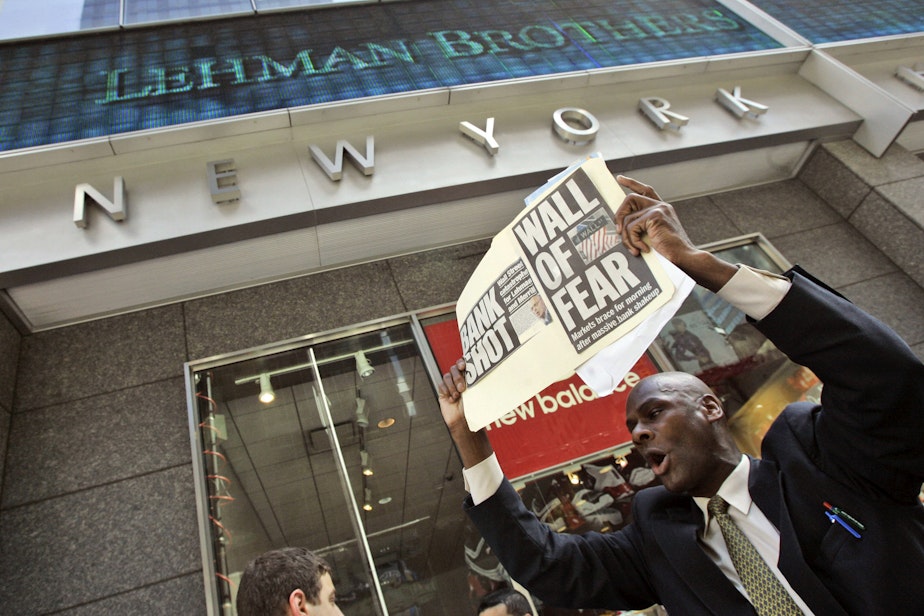The 2008 Financial Crisis, 10 Years Later: What Have We Learned?

With Meghna Chakrabarti
It’s been 10 years since Lehman Brothers collapsed and the nightmare of the global financial crisis. The author of the book “Too Big to Fail” takes us back to those frightening days.
Guests
Leo Murrieta, Director of Make The Road Nevada, a civil rights Organization that protects the rights of immigrants and working families in Nevada. He and his family were homeowners in zip code 89302 in North Las Vegas, one of the top-five hardest-hit zip codes in the country during the Great Recession. (@TheLMurrieta)
Andrew Ross Sorkin, columnist and assistant editor of business and finance at the New York Times and the founder and editor-at-large of DealBook, the paper’s online daily financial report. Co-anchor of CNBC’s “Squawkbox.” Author of “Too Big to Fail: How Wall Street and Washington Fought to Save the Financial System — and Themselves.” (@andrewrsorkin)
From The Reading List
CNBC Documentary: “Crisis On Wall Street: The Week That Shook The World”
New York Times: “From Trump to Trade, the Financial Crisis Still Resonates 10 Years Later” — “This week is the 10th anniversary of the inflection point of the financial crisis: the collapse of Lehman Brothers, the biggest bankruptcy in history. To some, it feels like a long time ago.
“Yet, its effects still echo in the way we live today — in the attitudes that pervade our economy, our culture and our politics. It is hardly a stretch to suggest that President Trump’s election was a direct result of the financial crisis.
“The crisis was a moment that cleaved our country. It broke a social contract between the plutocrats and everyone else. But it also broke a sense of trust, not just in financial institutions and the government that oversaw them, but in the very idea of experts and expertise. The past 10 years have seen an open revolt against the intelligentsia.
“Mistrust led to new political movements: the Tea Party for those who didn’t trust the government and Occupy Wall Street for those who didn’t trust big business. These moved Democrats and Republicans away from each other in fundamental ways, and populist attitudes on both ends of the spectrum found champions in the 2016 presidential race in Senator Bernie Sanders and Donald J. Trump.
“The depth of financial despair during the Great Recession and the invariably slow recovery have unleashed a sense of bitterness that dominates the political landscape, culminating in Mr. Trump’s electoral victory.”
Financial Times: “Financial crisis 2008: A reporter’s memories from the front lines”
New York Times: “Opinion: What We Need to Fight the Next Financial Crisis” — “Ten years ago, the global economy teetered in the face of a classic financial panic, the most dangerous type of financial crisis. In a financial panic, investors lose confidence in all forms of credit, retreating to the safest and most liquid assets, like Treasury bills. The prices of risky assets collapse, and new credit becomes unavailable, with dire consequences for workers, homeowners and savers.
“The seeds of the panic were sown over decades, as the American financial system outgrew the protections against panics that were put in place after the Great Depression. Depression-era safeguards, like deposit insurance, were aimed at ensuring that the banking system remained stable, but by 2007 more than half of all credit flowed outside banks. Financial innovations, like subprime mortgages and automated credit scoring, helped millions to buy homes, but they also facilitated unwise risk-taking by lenders and investors.
“Most dangerously, trillions of dollars of risky credit were financed by uninsured, short-term funding. This made the financial system vulnerable to runs — not by ordinary bank depositors, as in the 1930s, but by pension funds, life insurance companies, and other investors. A Balkanized and antiquated regulatory system made identifying these risks difficult and provided policymakers with limited authority to respond when the panic erupted.”
Wall Street Journal: “Why Bush’s Quiet Role in Financial Crisis Deserves Attention Now” — “The day after Lehman Brothers failed, Treasury Secretary Henry Paulson and Federal Reserve Chairman Ben Bernanke went to President George W. Bush with bad news. Insurer American International Group Inc. needed $85 billion or it, too, would collapse.
“Though unhappy and frustrated, Mr. Bush approved the loan, saying, ‘If we suffer political damage, so be it,’ Mr. Paulson later wrote.
“Scholars of the crisis rightly focus on the decisions that the three crisis managers—Mr. Paulson, Mr. Bernanke and New York Fed President Tim Geithner—made to rescue the financial system. Though unpopular at the time and still second-guessed, their actions were vital in avoiding a second Great Depression. Yet most would have been impossible without the president’s support, which Mr. Bush gave unreservedly from start to finish.” [Copyright 2018 NPR]
